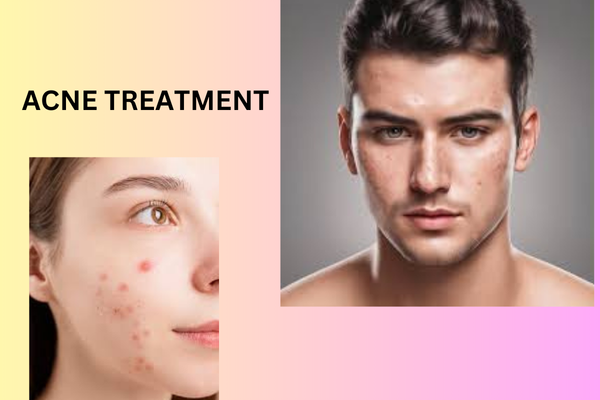Pimples, also known as acne, are a common skin condition that occurs when hair follicles become clogged with oil and dead skin cells. Although they are often associated with puberty, pimples can affect people of all ages. Understanding the causes, treatment options, and prevention strategies for pimples is critical to effectively managing this condition.
Table of Contents
Togglecauses of pimples:
. Although pimples (acne) is usually associated with youth, it can affect people of all ages. Understanding the various factors that contribute to the development of pimples is essential for effective prevention and treatment. Below are the main causes of pimples;
1. Excess oil production (sebum):
Sebaceous glands located beneath the surface of the skin produce an oily substance called sebum. Sebum helps lubricate and protect the skin.
Excessive sebum production can lead to clogged pores, which provides an ideal environment for acne-causing bacteria to thrive.
2. Bacteria (Propionbacterium acinus):
Propionbacterium acnes (P. acnes) is a type of bacteria that naturally lives on the skin.
When pores become clogged with excess oil and dead skin cells, P. acnes can grow rapidly, leading to inflammation and the formation of pimples.
3. Hormonal Changes:
Fluctuations in hormones, especially during puberty, menstruation, pregnancy and menopause, can affect sebum production.
Increased levels of hormones such as androgens stimulate the sebaceous glands, causing more oil production and a greater chance of pimples.
4. Genetics:
Family history plays an important role in determining an individual’s susceptibility to acne.
If one or both parents had acne, it is more likely that their children will also suffer from acne.
5. Clogged Hair Follicles:
Dead skin cells can accumulate on the skin’s surface and mix with sebum, causing hair follicles to become blocked.
This blockage, known as a comedone, can appear as either a whitehead (closed comedone) or a blackhead (open comedone), which can turn into pimples if left untreated.
6. Diet:
Although the relationship between diet and acne is still being researched, some studies show that certain foods can aggravate acne in susceptible individuals.
Foods rich in high glycemic index carbohydrates, dairy products, and saturated fat can contribute to the development of acne in some people.
7. Stress:
Stress triggers the release of hormones like cortisol, which can increase sebum production and inflammation in the skin.
Chronic stress can worsen existing acne or trigger new breakouts in susceptible individuals.
8. Medicines:
Some medications, such as corticosteroids, androgens, and lithium, can contribute to the development of acne as a side effect.
These medications can affect hormone levels or increase sebum production, leading to acne flare-ups.
9. Environmental Factors:
Environmental pollution, humidity, and exposure to certain skin care or cosmetic products can irritate the skin and contribute to the development of acne.
Prolonged exposure to oily or greasy substances can also aggravate existing acne.
10. Lifestyle Habits:
Poor skin care habits, such as insufficient cleansing or excessive scrubbing, can cause itchy skin and worsen acne.
Using harsh skin care products or makeup that clogs pores can also contribute to the development of acne.
Finally, pimples are caused by a number of factors, including overproduction of oil, bacterial overgrowth, hormonal changes, genetics, diet, stress, medications, environmental factors and lifestyle habits. Although some factors, such as genetics, cannot be changed, adopting a consistent skincare routine, managing stress levels, maintaining a healthy diet, and avoiding acne triggers can reduce the frequency and severity of acne breakouts. I can help. Seeking guidance from a dermatologist can provide personalized recommendations to effectively manage acne.

The Comprehensive Guide to Treating Pimples:
Pimples (acne) can be effectively managed with different treatment methods depending on the severity of the disease and the underlying causes. Treatment aims to reduce inflammation, unclog pores, kill acne-causing bacteria and prevent future breakouts. Below is a comprehensive guide to treating pimples:
1. Over-the-counter (OTC) topical treatments:
Benzol Peroxide: Benzol peroxide is a powerful antibacterial agent that helps kill acne-causing bacteria and reduce inflammation. It also helps unclog pores by removing excess oil and dead skin cells. Available in various strengths, benzoyl peroxide can be found in gels, creams, and washes.
Salicylic Acid: Salicylic acid cleanses the skin, helps unclog pores and prevent new acne breakouts. It also has anti-inflammatory properties. Salicylic acid is commonly found in cleansers, toners, and spot treatments.
Sulfur: Sulfur helps remove excess oil and dead skin cells, unclog pores and reduce inflammation. It is often used in combination with other acne-fighting ingredients in spot treatments and masks.
Retinoids: Topical retinoids, such as adapalene, tretinoin, and tazarotene, help unclog pores, prevent new acne lesions, and promote skin cell turnover. They may cause skin dryness and irritation initially but can be very effective in the long run.
2. Prescription Conditional Treatments:
Topical antibiotics: Antibiotics such as clindamycin and erythromycin may be prescribed to reduce acne-causing bacteria and inflammation. They are often used in combination with treatments for other conditions to prevent bacterial resistance.
Combination Topical: Some prescription medications combine ingredients like benzoyl peroxide with topical antibiotics or retinoids for better efficacy and convenience.
3. Oral medications:
Antibiotics: Oral antibiotics such as doxycycline, minocycline, and tetracycline are prescribed for moderate to severe acne to reduce inflammation and kill bacteria. They are usually used for short-term treatment because of the risk of antibiotic resistance.
Hormonal therapy: Oral contraceptives containing estrogen and progestin (birth control pills) can control hormone levels and reduce sebum production in women with hormonal acne.
Isotretinoin (Accutane): Isotretinoin is a potent oral retinoid used to treat severe, nodular acne that has not responded to other treatments. It reduces sebum production, shrinks oil glands, and prevents new acne breakouts but requires close monitoring due to potential side effects.
4. Dermatological procedures:
Extraction: Dermatologists can manually extract comedones (whiteheads and blackheads) using special tools to close pores and reduce the risk of infection.
Chemical peels: Chemical peels that contain ingredients such as salicylic acid, glycolic acid, or trichloroacetic acid can help clear skin, unclog pores, and improve the appearance of acne scars.
Laser therapy: Laser and light-based treatments target acne-causing bacteria, reduce inflammation, and promote collagen production, which clears skin. Options include laser therapy, intense pulse light (IPL), and photodynamic therapy (PDT).
5. Lifestyle and Home Remedies:
Healthy skincare routine: Cleanse skin twice daily with a mild cleanser, avoid harsh scrubbing or over-washing, and use a non-comedogenic moisturizer and sunscreen.
Dietary changes: Some people may benefit from reducing their intake of high-glycemic index carbohydrates, dairy products, and foods rich in saturated fat. Eating a balanced diet with plenty of fruits, vegetables, and whole grains can promote overall skin health.
Stress management: Stress reduction techniques such as mindfulness, meditation, yoga, and regular exercise can help manage stress-related acne flare-ups.
6. Professional guidance and follow-up:
Consult a dermatologist for a personalized diagnosis and treatment recommendations based on your specific skin type, acne severity, and medical history.
Follow up regularly with your dermatologist to monitor treatment progress, adjust medications as needed, and address any concerns or side effects.
Finally, treating acne (acne) requires a multifaceted approach, including topical and oral medications, dermatological procedures, lifestyle changes, and consistent skin care practices. By working closely with a dermatologist and implementing appropriate treatment strategies, individuals can effectively manage acne and achieve clear, healthy skin.
Prevention:
Maintain good hygiene: Cleanse the face regularly with a gentle cleanser to remove excess oil, dirt and impurities that can contribute to the development of facial acne.
Avoid touching your face: Avoid touching your face unnecessarily, as this can transfer bacteria and irritate the skin, potentially making facial acne worse.
Practice stress management: Engage in stress-reducing activities such as exercise, meditation, yoga, or deep breathing exercises to help manage stress levels, which can contribute to facial acne flare-ups. can
Follow a healthy diet: Eat a balanced diet rich in fruits, vegetables, whole grains and lean protein, and limit your intake of high-glycemic index carbohydrates and dairy products, which can aggravate facial acne in some people.
Get professional help: Consult a dermatologist for a personalized diagnosis and treatment recommendations based on your specific skin type and acne severity. Dermatologists can provide expert guidance and prescribe appropriate medications or procedures to help effectively manage pimples (facial acne).
Conclusion:
In conclusion, Pimples(facial acne )can be a difficult condition to manage, but with the right treatment approach and precautions, individuals can achieve clear, healthy skin. By addressing the underlying causes of pimples and following a comprehensive treatment plan, individuals can reduce breakouts and improve their overall skin health and confidence.

